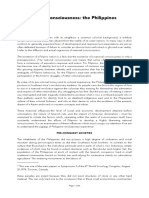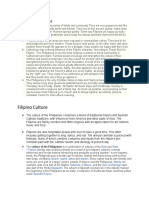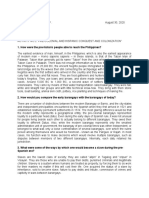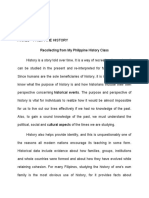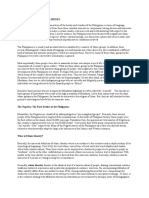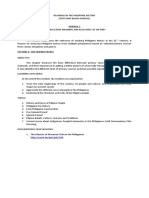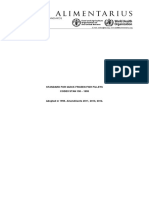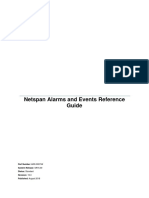Manlapaz - ADVENT OF SPAIN ESSAY
Manlapaz - ADVENT OF SPAIN ESSAY
Uploaded by
Glenn C. Batincila Jr.Copyright:
Available Formats
Manlapaz - ADVENT OF SPAIN ESSAY
Manlapaz - ADVENT OF SPAIN ESSAY
Uploaded by
Glenn C. Batincila Jr.Original Title
Copyright
Available Formats
Share this document
Did you find this document useful?
Is this content inappropriate?
Copyright:
Available Formats
Manlapaz - ADVENT OF SPAIN ESSAY
Manlapaz - ADVENT OF SPAIN ESSAY
Uploaded by
Glenn C. Batincila Jr.Copyright:
Available Formats
Mary Dorothy S.
Manlapaz
BS-Entrepreneurship
GEC 105, W23
THE ADVENT OF SPAIN COLONIZATION
A society is often distinguished as a group of people that have
consistent and constant interactions with one another. It can also be a
group of individuals that share the same geographic territory, political
upperhand and the culture and traditions dominating the population. It is
inevitable for a society to change and develop as a result of the cycle of
time and the consequences it brings. Like many other countries, our very
own nation, the Philippines have been known to have undergone quite the
series of social transformations. These changes have been recorded even
from the first humans that set foot on our island, down to the colonial era
of the different countries, and to our present and modern day society.
Indeed, the things that we enjoy today are all thanks to all the
dramas,wars, disputes and everything that happened before our times.
The journey of Philippine society has become like a rollercoaster
ride throughout its history. From the pre-colonial era to the spanish period
and down to the liberation of the country. The Philippines is the only
country in the southeast asian region that was not able to establish an
independent centralized government before the colonization of different
countries. This statement clearly shows how our ancestors have been
dependent on the culture and traditions of other countries. The first set of
foreigners that arrived in our country would mostly be the
Austro-Melanesian and the Malays that were believed to be from the
islands of Java, Borneo, Sumatra, and more. These first inhabitants were
solely focused on their day to day survival. Some suggested that if the
Philippines had not been discovered by Ferdinand Magellan, it would have
remained as uncivilized and uncultured as before. However, certain
studies have proven that this belief would be considered as false. The first
inhabitants of the Philippines were actually skilled when it came to
hunting and fishing. They weren’t completely uncivilized or the cave man
type.
The Philippines in the past has always been vibrant with the
colors of ethnicity. Different dialects from unique tribes that rely on their
ethnicity and language to determine who is a friend and who is a
stranger. The beauty and diversity of the Philippines does not only
apply to its human communities, but to the wonders of the species
within its vicinity. Before the Philippines was even recognized as the
Philippines as we all know today, it was more described as an
archipelago, a cluster of islands. Filled with creatures with color, the
archipelago of what is named now as Philippines prospers with life,
unlike now, some of the species in the island have disappeared, not
only the animals, but these ethnic communities as well. Since
pre-Hispanic times there have been a number of tribes from across the
archipelago.
It was then, subsequently, the particularization of the Philippine
bona fide cycle inside an obvious geographic and organic structure that
gave what might be known as the beginning phase justification for a
paramount social fortitude in the Philippine archipelago. What displayed
as a transcendent viewpoint in the progression of organizations in the
Philippines until the establishment of the Spanish pioneer
superstructures all through the archipelago was the insurance and
advancement of strong ethnic traditions which have found undeniable
explanations in oral composition. As such, from Northern Luzon toward
the southernmost piece of the archipelago, we track down the different
instances of ethnic records, legends, tunes, questions, adages, and
pictures, similarly as customs and chips away at being kept in clever
and extensive affiliation and interrelationship by the fascinating
illustration of the Philippine chronicled measure.
This is avowed by the examinations of new similarly as
neighborhood analysts. This is the thing that in a way is being stressed
by the theory which sees the uniqueness of Philippine recorded
progression as embellishing the character of Philippine culture and
giving its own special rhythm. Thus, "assortment" is an undeniable
quality of social headway all through Philippine genuine reality which is
being clarified by a course of social recuperation in contemporary
events. In this sense, Philippine composition, which is one of the most
self-evident and incredible strategies for recuperation, must have
acquired a truly huge estimation not equivalent to the common design
and substance it has swallowed since Spanish events. Subsequently,
to appreciate the uniqueness of ethnic social orders and their
significance, one necessities to relate them to the greater grid of
Philippine culture which is a thing not of a singular ethnic practice yet
rather of an altogether more wide and huge bona fide cycle.
Regardless, over the range of progression, outside factors at different
events in history changed the ethnic lines of progress and have since
become instrumental and, believe it or not, conclusive in the
improvement of what has been lamentably insinuated as Filipino public
character and mentality.
Among the three long centuries of ruling the country, Spain’s
cultural legacy and religious beliefs were the most beneficial and
comprehensive to the Philippines rather than the political and economic
aspirations. Several aspects of Philippine culture have been altered or
completely changed and greatly influenced. Christianity originated from
Asia, being founded by Jesus Christ and Palestine, spread to Western
Europe and propagated across the Atlantic to the new world and across
the pacific and to the Philippines, this was the most outstanding
achievement of the Spanish Missionary that was done with the Spanish
conquistadores. During the Spanish era, families were simple and
wholesome. The father is the master of the household while the mother
is the first tutor. It was known that broken families were rare in the old
generation. Children kissing their parent’s hands became a sign of
respect. Filipino women are given elevated positions and respected by
men, although they have limited freedom for studies, engaging in
professions, and to mix freely with men. Those who have the means to
study often enter exclusive schools for women, while those who don’t
have interest in marrying often result in entering the convent to pursue
being a nun. The Spaniards also introduced their food and food plants
where the Filipinos started to learn how to eat bread, ham, and other
stereotypical European foods. Table manners were also taught by the
colonizers. In terms of clothing, men started to wear western clothes
such as trousers,hats, slippers, and shoes. Women used to incorporate
jewelry in their daily outfits. These women wore saya, camisa, slippers,
and stockings. Although through the years, all of these cultures may
have been dumped on and no longer being used. However, a lot of the
things and the characteristics of filipino citizens came from the spanish
colonization and up to this very moment, filipinos are living with it.
Societies will always change and that applies to each and every
existing society in this world, whether it’s a small or a big society. The
Philippines under those three long centuries of Spanish colonization
had its fair share of goodness and madness. Spain instilled the idea of
nationalism in our country that until now, it is still very evident in our
society.
You might also like
- Identity and ConsciousnessDocument30 pagesIdentity and ConsciousnessGherald Edaño100% (4)
- A Syncretic Culture by Paul Rodell PDFDocument9 pagesA Syncretic Culture by Paul Rodell PDFVenice SorianoNo ratings yet
- Concrete Recycling - Research and PracticeDocument659 pagesConcrete Recycling - Research and Practicekarim hassanNo ratings yet
- Abdulrahim Ge11 Midterm ExminationDocument5 pagesAbdulrahim Ge11 Midterm Exminationsittie aisah abdulrahimNo ratings yet
- The Philippines A Past Revisited Critique PaperDocument10 pagesThe Philippines A Past Revisited Critique PaperIDate DanielNo ratings yet
- Culture and History by Nick Joaquin Term PaperDocument7 pagesCulture and History by Nick Joaquin Term Papereieipayad25% (4)
- Social Classes in The Philippines 123Document11 pagesSocial Classes in The Philippines 123Monalyn SamperNo ratings yet
- The Islands Were Composed of Different Kingdoms, Rajahnates and SultanatesDocument1 pageThe Islands Were Composed of Different Kingdoms, Rajahnates and SultanatesShawnNo ratings yet
- The Islands Were Composed of Different Kingdoms, Rajahnates and SultanatesDocument1 pageThe Islands Were Composed of Different Kingdoms, Rajahnates and SultanatesShawnNo ratings yet
- The Islands Were Composed of Different Kingdoms, Rajahnates and SultanatesDocument1 pageThe Islands Were Composed of Different Kingdoms, Rajahnates and SultanatesShawnNo ratings yet
- GEED 003 ASSIGN1 GROUP 10Document8 pagesGEED 003 ASSIGN1 GROUP 10Glenn AgooNo ratings yet
- Preliminary Exa1Document2 pagesPreliminary Exa1Rissa DeclaroNo ratings yet
- The Filipino SocietyDocument5 pagesThe Filipino SocietyjennylynNo ratings yet
- Process of Westernization Group 1.Document5 pagesProcess of Westernization Group 1.Unknown UnknownNo ratings yet
- RPH MODULE 4 - MidtermDocument6 pagesRPH MODULE 4 - MidtermLord Ivan PanchoNo ratings yet
- Filipino CharacterDocument7 pagesFilipino CharacterJoanna Jopay M. LuayonNo ratings yet
- Essential Questions Week 4Document6 pagesEssential Questions Week 4Sara CapagueNo ratings yet
- Culture and Society of The PhilippinesDocument21 pagesCulture and Society of The PhilippinesJean PangoNo ratings yet
- Spanish Colonialism in Today's PhilippinesDocument3 pagesSpanish Colonialism in Today's PhilippinesAllenGlennLagadoNo ratings yet
- RPH KimDocument2 pagesRPH KimCherry KimNo ratings yet
- VILDOZOLA - N2 - Activity No. 2-PRE-COLONIAL & HISPANIC CONQUEST AND COLONIZATIONDocument5 pagesVILDOZOLA - N2 - Activity No. 2-PRE-COLONIAL & HISPANIC CONQUEST AND COLONIZATIONShekainah Jane VildozolaNo ratings yet
- Filipino CultureDocument45 pagesFilipino CultureMichelle DaquelNo ratings yet
- Dynamism, Diversity and EclecticismDocument5 pagesDynamism, Diversity and EclecticismSamuelNo ratings yet
- 21st Pre Colonial PeriodDocument9 pages21st Pre Colonial PeriodANT0N1ONo ratings yet
- Inbound 6096990047000940831Document6 pagesInbound 6096990047000940831Lucky GalangNo ratings yet
- The Galleon Trade Was A Government MonopolyDocument4 pagesThe Galleon Trade Was A Government Monopolykeitch jonh Salvador0% (1)
- PHIL.-CULTUREDocument23 pagesPHIL.-CULTURELiana SantosNo ratings yet
- Mel John CatalanDocument7 pagesMel John CatalanasdsasasadsadsadsadsadsadNo ratings yet
- Group 3-RizalDocument24 pagesGroup 3-RizalYvonmae PedeNo ratings yet
- The Education System of The Philippines Research - FinalDocument16 pagesThe Education System of The Philippines Research - FinalEla Mae SayodNo ratings yet
- How Does Western Culture Influence The Philippines?Document4 pagesHow Does Western Culture Influence The Philippines?Wilfredo C. Batohinog100% (1)
- Kyle Lit Review Pop CultureDocument4 pagesKyle Lit Review Pop CultureCyril CauilanNo ratings yet
- Pre-Colonial PeriodDocument1 pagePre-Colonial PeriodJoevanie NunezNo ratings yet
- Bsa - 3 Finals - Philippine History Recollecting From My Philippine History ClassDocument4 pagesBsa - 3 Finals - Philippine History Recollecting From My Philippine History Classjohn condesNo ratings yet
- B06 Majul - Islamic and Arab Cultural InfluencesDocument14 pagesB06 Majul - Islamic and Arab Cultural Influencescrisostomopaulsymon16No ratings yet
- Phil - Pre-Colonial-Revise 1Document13 pagesPhil - Pre-Colonial-Revise 1jamaica agustinNo ratings yet
- Gen. Type of Literature - Bancale, JasperDocument6 pagesGen. Type of Literature - Bancale, Jasperjessa mae bancaleNo ratings yet
- THE PHILIIPPINES: The Past Revisited by Renato ConstantinoDocument8 pagesTHE PHILIIPPINES: The Past Revisited by Renato ConstantinoChristian VillaNo ratings yet
- THE PHILIIPPINES: The Past Revisited by Renato ConstantinoDocument8 pagesTHE PHILIIPPINES: The Past Revisited by Renato ConstantinoChristian VillaNo ratings yet
- Unit 1 Alternative Reading in Philippine HistoryDocument8 pagesUnit 1 Alternative Reading in Philippine HistoryEarl LambolotoNo ratings yet
- Script For g9 Reporting Phil 1historyDocument4 pagesScript For g9 Reporting Phil 1historyErika Faith NiezNo ratings yet
- Filipino Cultures and ValuesDocument21 pagesFilipino Cultures and ValuesCatherine Phoebe CancioNo ratings yet
- Understanding Culture, Heritage and The FilipinosDocument5 pagesUnderstanding Culture, Heritage and The FilipinosJovito ReyesNo ratings yet
- Customs of The Tagalog Performance TaskDocument3 pagesCustoms of The Tagalog Performance Tasktimothy corpuzNo ratings yet
- Untitled Document PDFDocument12 pagesUntitled Document PDFMa. Patricia Micaela Yambao SouzaNo ratings yet
- In Perspective of ReligionDocument4 pagesIn Perspective of ReligionJOHNHARVEY ALPINONo ratings yet
- Effects of Spanish ColonizationDocument2 pagesEffects of Spanish ColonizationGherald Edaño60% (5)
- Society, Economy, History, PoliticsDocument6 pagesSociety, Economy, History, PoliticsArthur BlatNo ratings yet
- Ethnic Groups in The Philippines: The Negritos: The First Settlers of The PhilippinesDocument4 pagesEthnic Groups in The Philippines: The Negritos: The First Settlers of The PhilippinesAldrin Jules BiloNo ratings yet
- Birth of Filipino NationalismDocument24 pagesBirth of Filipino NationalismChristina BinoboNo ratings yet
- Module 2Document6 pagesModule 2玛丽亚No ratings yet
- THE PHILIIPPINES: The Past Revisited by Renato ConstantinoDocument8 pagesTHE PHILIIPPINES: The Past Revisited by Renato ConstantinoLOIS ANNE RAZONNo ratings yet
- RPH Spanish HeritageDocument56 pagesRPH Spanish HeritageRazel De DiosNo ratings yet
- Asenas - Ge2 - Filipino Students in SpainDocument2 pagesAsenas - Ge2 - Filipino Students in SpainCleofe Mae Piñero AseñasNo ratings yet
- Understanding Culture Heritage and The FilipinosDocument7 pagesUnderstanding Culture Heritage and The FilipinosLig KramNo ratings yet
- Cultural, Political, and Economic Changes in The: PhilippinesDocument35 pagesCultural, Political, and Economic Changes in The: PhilippinesGEN VLOGSNo ratings yet
- The Moros and The Majority FilipinosDocument12 pagesThe Moros and The Majority FilipinosSean Christian DinglasanNo ratings yet
- The Age of DiscoveryDocument2 pagesThe Age of DiscoveryLyza FortunaNo ratings yet
- Filipino People of Spanish AncestryDocument7 pagesFilipino People of Spanish AncestryLinas KondratasNo ratings yet
- Spanish ColonizationDocument2 pagesSpanish ColonizationMark ANo ratings yet
- Monarch of the Philippine Nation: Monarchy of GovernmentFrom EverandMonarch of the Philippine Nation: Monarchy of GovernmentNo ratings yet
- List of OSD TCSTC Holders ContactsDocument3 pagesList of OSD TCSTC Holders ContactsBruno Alonso PachecoNo ratings yet
- Quick Start GuideDocument10 pagesQuick Start Guidesvic11No ratings yet
- Standard For Quick Frozen Fish Fillets Codex Stan 190 - 1995Document7 pagesStandard For Quick Frozen Fish Fillets Codex Stan 190 - 1995remyNo ratings yet
- Drilling With Liner (DWL) SystemDocument12 pagesDrilling With Liner (DWL) SystemBelhadj Mohammed NafaaNo ratings yet
- 1Document5 pages1Reniella HidalgoNo ratings yet
- Blog 3 Advantages of Solar EnergyDocument2 pagesBlog 3 Advantages of Solar EnergyEMAMUL KABIRNo ratings yet
- Grain and Soybean Drying On Georgia FarmsDocument13 pagesGrain and Soybean Drying On Georgia FarmsjimNo ratings yet
- Flow Analyses Inside Jet Pumps Used For Oil WellsDocument11 pagesFlow Analyses Inside Jet Pumps Used For Oil WellsAamir SultanNo ratings yet
- Skydeals - BOQ - BNEDocument14 pagesSkydeals - BOQ - BNENishant MishraNo ratings yet
- NIT DurgapurDocument115 pagesNIT DurgapurSayak DasNo ratings yet
- Cement Testing PDFDocument33 pagesCement Testing PDFnk_kanchkar93% (14)
- Anemia NCPDocument5 pagesAnemia NCPMel Christian Baldoz100% (2)
- Syllabus Fire and SafetyDocument15 pagesSyllabus Fire and SafetyDeepmala SuryawanshiNo ratings yet
- Li Fi WikipediaDocument13 pagesLi Fi WikipediaMohitNo ratings yet
- ProspectousDocument62 pagesProspectousSimarjeet MattuNo ratings yet
- Bison & Walrus Error CodesDocument5 pagesBison & Walrus Error Codesalsomate.mNo ratings yet
- MecanicaDocument18 pagesMecanicawilson claveriaNo ratings yet
- AVEVA-NET-Workhub-Dashboard PDF Coredownload InlineDocument2 pagesAVEVA-NET-Workhub-Dashboard PDF Coredownload InlineSmriti GargNo ratings yet
- ARD-D00742 - Netspan Alarms and Events Reference Guide - SR16.00 - Standard - Rev 10.3Document250 pagesARD-D00742 - Netspan Alarms and Events Reference Guide - SR16.00 - Standard - Rev 10.3curtiskamotoNo ratings yet
- Introduction To Beamer and Tikz: Christian SchnellDocument48 pagesIntroduction To Beamer and Tikz: Christian SchnellGustavo G Borzellino CNo ratings yet
- Art Integration Project - Class 8Document2 pagesArt Integration Project - Class 8kartikey singhNo ratings yet
- Exampro GCSE Chemistry: C3 Chapter 4 HigherDocument37 pagesExampro GCSE Chemistry: C3 Chapter 4 HigherAayma MunirNo ratings yet
- 5G TransportDocument42 pages5G TransportDaniel Cafu100% (1)
- Experiment: Analysis of A Freely-Falling Body: Behr Free Fall SystemDocument5 pagesExperiment: Analysis of A Freely-Falling Body: Behr Free Fall SystemmohitNo ratings yet
- Kernicterus. IfDocument2 pagesKernicterus. IfValledor Ian MosesNo ratings yet
- Manonmaniam Sundaranar University: B.B.A. - Ii YearDocument61 pagesManonmaniam Sundaranar University: B.B.A. - Ii YearLovely Dhanaa4848No ratings yet
- Science 5 Q4-Week 2Document11 pagesScience 5 Q4-Week 2joan marie PeliasNo ratings yet
- Rules of Chart Interpretation and Evaluation of Polygraph ResultsDocument8 pagesRules of Chart Interpretation and Evaluation of Polygraph ResultsNick clarence SolimanNo ratings yet
- Gigabyte Ga-8i945pl-G Rev 1.1Document44 pagesGigabyte Ga-8i945pl-G Rev 1.1siarheiNo ratings yet
